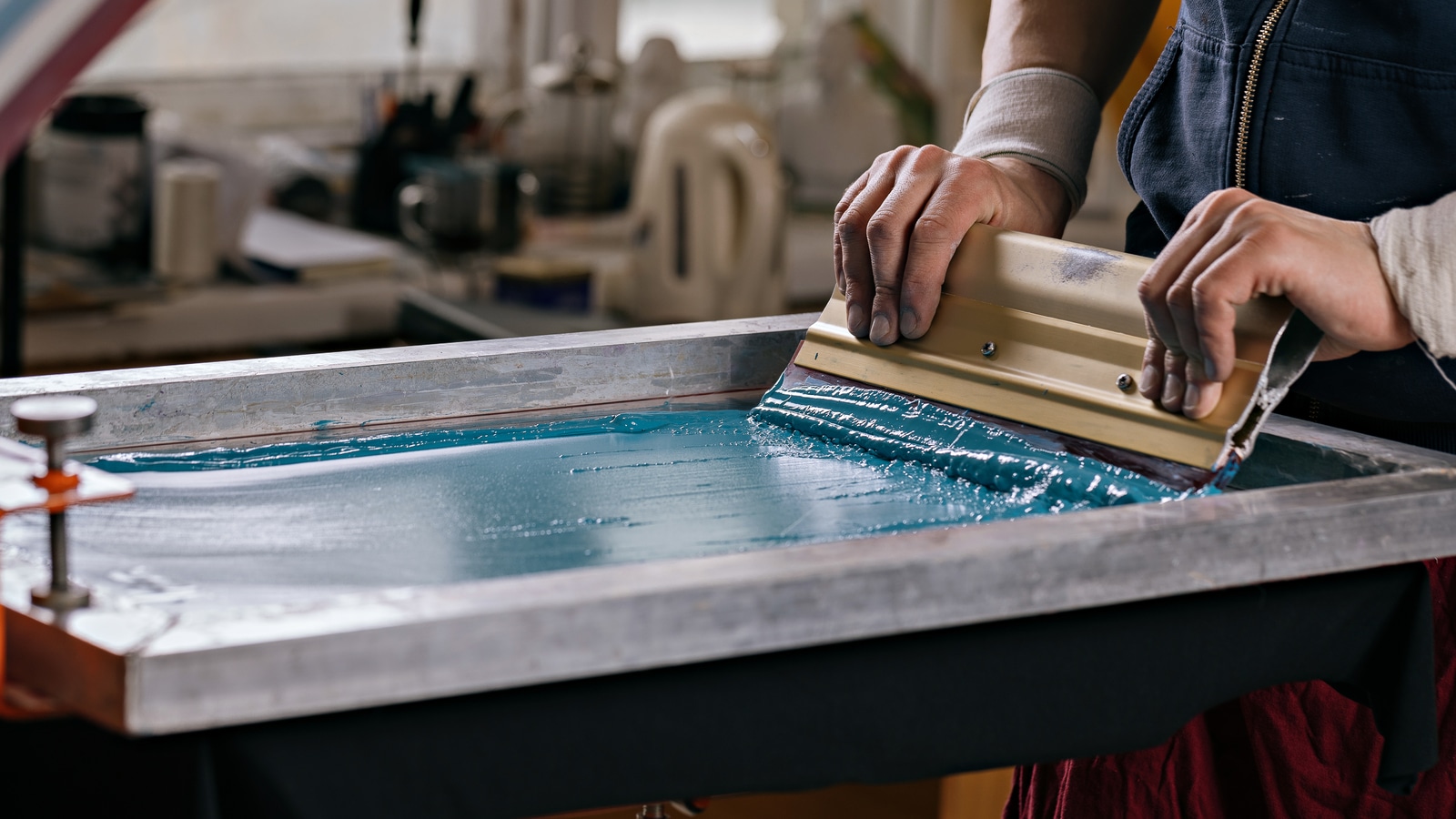Premium Screen Printing Kit for Business Startups
Premium Screen Printing Kit for Business Startups
Blog Article
Display Printing Uncovered: Everything You Required to Know About T-Shirt and Garment Printing Methods
If you have actually ever before questioned exactly how those vibrant designs wind up on your preferred tee shirts, you remain in the best area. Display printing is a fascinating approach that combines art with strategy, offering countless possibilities for imagination. Recognizing the fundamentals, from tools to ink choices, can greatly affect your outcomes. Ready to discover the essential components that make screen publishing an art type? Let's reveal the information that can elevate your projects.
The Essentials of Display Printing: How It Works
When you dive into screen printing, you'll uncover it's both an art and a science. At its core, display printing entails producing a stencil, or display, that enables ink to pass with only in details areas (screen printing kit). You start by picking your style and preparing your display with a light-sensitive solution. As soon as you subject this emulsion to light, it sets, leaving your design as a negative space.
Position the screen over the fabric, after that use a squeegee to press ink via the screen onto the garment. Each step is vital, and grasping them will elevate your screen printing skills, transforming straightforward garments into special, meaningful items.
Sorts Of Display Printing Techniques
As soon as you grasp the basics of screen printing, it's time to check out the numerous methods that can elevate your styles. One preferred technique is typical display printing, where ink is pushed through a stenciled display. This strategy is wonderful for bold, vibrant shades. After that there's water-based ink printing, which offers a softer feel and is green, but it needs a various technique to healing.
One more choice is plastisol printing, understood for its resilience and vivid colors, making it a preferred for many brand names. Experiment with halftone printing to create slope effects and intricate designs.
Necessary Devices for Display Printing
To accomplish magnificent cause display printing, having the ideal equipment is basic. You'll require a tough display printing framework, which holds the mesh that moves your layout onto the garment. Next off, invest in top notch squeegees; these are important for applying ink equally across the screen. You'll likewise call for a good direct exposure system to create your displays, as well as a washout cubicle for cleaning them after use. A reputable heat source, like a conveyor clothes dryer or heat press, is important for treating your prints to assure longevity. Do not neglect an appropriate office, outfitted with tables and storage for your products. Lastly, protective gear, such as masks and gloves, will maintain you risk-free from chemicals and inks. With the right tools, you'll be well on your means to generating professional-quality prints.
Selecting the Right Inks and Materials
When choosing inks and products for display printing, you need to consider the kind of ink that works best for your project. Assume about material compatibility to guarantee your styles look excellent and last lengthy. Additionally, check out environment-friendly ink options to make your printing procedure much more sustainable.
Sorts Of Display Inks
Picking the best screen ink is crucial for accomplishing lively, durable prints that meet your project's requirements. There are numerous sorts of display inks to examine. Plastisol ink is preferred for its flexibility and simplicity of usage, giving outstanding color opacity on dark textiles. Water-based ink, on the other hand, supplies a softer feel and is environment-friendly, making it excellent for those wanting to minimize their ecological effect. Discharge inks remove color from the fabric, causing a soft, classic look yet call for certain handling. Specialized inks, such as glow-in-the-dark or metallic, can include special results to your styles. Examine your project requirements and select the ink that straightens best with your preferred outcome.

Textile Compatibility Considerations
Recognizing material compatibility is important for accomplishing top quality display prints, particularly given that various materials respond distinctively to numerous inks. When choosing inks, consider the textile type-- cotton, polyester, or blends. For cotton, water-based inks function well, using gentleness and breathability. Polyester, on the other hand, usually requires plastisol inks for better bond and dynamic colors. If you're publishing on blends, you may require to use a mix of both kinds. Constantly examine your inks on example textile to ensure they stick appropriately and maintain shade stability. Furthermore, keep in mind that material weight and structure official website can influence the final end result, so picking the ideal ink and material combo is important for your project's success.
Eco-Friendly Ink Options
Environment-friendly inks are coming to be a popular option for display printers that desire to reduce their environmental effect while maintaining quality. When picking inks, consider water-based inks, which are less harmful and less complicated to cleanse up compared to standard solvents.
Furthermore, seek inks made from eco-friendly sources, such as soy or vegetable-based choices. By selecting the right inks and products, you'll not just produce magnificent designs but also contribute to an extra sustainable printing process. Make the switch, and your prints will mirror your commitment to the setting!
Preparing Your Design for Screen Printing

Submit Style Needs
To assure your style looks vivid and sharp on textile, you'll need to pay close interest to file style needs for display printing. Beginning with vector documents like AI or EPS, as they can be scaled without losing quality. If you make use of raster images, select high-resolution files, such as TIFF or PNG, preferably at 300 DPI. Stay clear of using JPEGs, as they can lose quality when resized. Make sure your layout has a transparent history to prevent unwanted white edges on your prints. Finally, maintain color settings in mind; CMYK is conventional for screen printing, so convert your RGB makes accordingly. By following these standards, you'll set your artwork up for an effective print.
Shade Splitting Up Methods
Color splitting up is an essential step in preparing your style for display printing, and mastering it can greatly improve your print quality. You'll require to damage your layout into specific shades, as each shade requires a different screen during printing. This precision not just ensures exact shade representation yet likewise simplifies the printing procedure.
Resolution and Size
Achieving the most effective results in display printing begins with ensuring your layout has the best resolution and size. Ideally, your art work Discover More Here must be at the very least 300 DPI (dots per inch) for sharp, clear prints. If you utilize lower resolution, your end product might look unprofessional and pixelated.
When it comes to size, consider the dimensions of your print location. Layout your artwork to match the last print dimension, ideally developing it in the real dimensions you'll be printing. In this manner, you'll stay clear of any type of unforeseen scaling issues.
Constantly check your style in both vector and raster layouts. Vector graphics can be scaled without shedding quality, making them excellent for screen printing. Preparing correctly will guarantee your layout looks incredible on every garment!
Step-by-Step Screen Printing Process
Screen printing is a vibrant procedure that enables you to create dynamic styles on numerous surface areas. To get begun, you'll need a screen, solution, and your chosen ink.
Put ink onto the screen and utilize a squeegee to press the ink with the stencil onto the material. Lift the display very carefully and allow the print dry. You've effectively display published your style.
Tips for Successful Screen Printing Projects
While you're diving into your screen printing tasks, keep in mind that preparation is key to success. Start by collecting all your materials-- inks, garments, mops, and displays. A clean work space aids avoid undesirable errors, so clean up before you begin.
Next, validate your art work is high-resolution and effectively sized for your garment. Evaluate your display for proper direct exposure and clean it extensively to prevent smudges. When blending your inks, adhere to the producer's standards to attain the ideal consistency.
Throughout printing, apply even pressure with your squeegee for consistent outcomes. Don't rush; take your time to validate each print satisfies your criteria. After printing, allow your garments dry completely look at this site prior to dealing with or packaging them.
Last but not least, always maintain an example of your job for future reference. This method, you can evaluate your development and boost your techniques in time. Satisfied printing!

Often Asked Inquiries
Just how Long Does It Require To Establish up a Display Printing Task?
Establishing up a display printing work normally takes around thirty minutes to an hour. You'll prepare the displays, mix inks, and adjust journalism. The moment varies based on intricacy and experience, so stay organized!
Can I Publish on Various Fabric Types Utilizing the Same Strategy?
Yes, you can print on various fabric types making use of the same technique, however you'll require to adjust your inks and settings. Some textiles soak up ink differently, so experimenting warranties the most effective outcomes for each and every product.
What Prevail Mistakes to Stay Clear Of in Screen Printing?
When display printing, prevent typical mistakes like using the incorrect ink, ignoring appropriate direct exposure times, or skipping pre-press checks. Always test your arrangement and maintain clean screens to guarantee high quality outcomes each time.
How Can I Effectively Tidy and Preserve My Display Printing Tools?
To effectively tidy and keep your screen printing devices, you need to regularly clean screens with ideal solvents, examine squeegees for wear, and assure all devices are kept dust-free and completely dry. Uniformity avoids pricey repair services and enhances performance.
Is Display Printing Ecologically Friendly Compared to Various Other Techniques?
Screen printing can be extra eco-friendly than other techniques, particularly if you use eco-conscious products and water-based inks. By choosing sustainable materials and techniques, you lower waste and decrease your influence on the world.
Display Printing Uncovered: Every Little Thing You Required to Know Regarding T-Shirt and Garment Printing Methods
At its core, screen printing includes developing a pattern, or screen, that enables ink to pass with just in certain locations. Placement the screen over the fabric, after that utilize a squeegee to push ink with the screen onto the garment. One prominent approach is traditional screen printing, where ink is pushed via a stenciled display.When picking inks and materials for screen printing, you need to take right into account the type of ink that functions ideal for your job.
Report this page